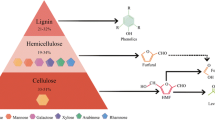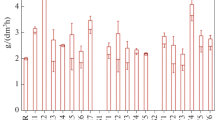Abstract
To increase thermotolerance and ethanol tolerance in Saccharomyces cerevisiae strain YZ1, the strategies of high-energy pulse electron beam (HEPE) and three rounds of protoplast fusion were explored. The YF31 strain had the characteristics of resistant to high-temperature, high-ethanol tolerance, rapid growth and high yield. The YF31 could grow on plate cultures up to 47 °C, containing 237.5 g L−1 of ethanol. In particular, the mutant strain YF31 generated 94.2 ± 4.8 g L−1 ethanol from 200 g glucose L−1 at 42 °C, which was 2.48 times the production of the wild strain YZ1. Results demonstrated that the variant phenotypes from the strains screening by HEPE irradiation could be used as parent stock for yeast regeneration and the protoplast fusion technology is sufficiently powerful in combining suitable characteristics in a single strain for ethanol fermentation.




Similar content being viewed by others
References
Ma M, Liu ZL (2010) Mechanisms of ethanol tolerance in Saccharomyces cerevisiae. Appl Microbiol Biotechnol 87(3):829–845
Stanley D, Bandara A, Fraser S, Chambers PJ, Stanley GA (2010) The ethanol stress response and ethanol tolerance of Saccharomyces cerevisiae. J Appl Microbiol 109(1):13–24
Olofsson K, Bertilsson M, Liden G (2008) A short review on SSF—an interesting process option for ethanol production from lignocellulosic feedstocks. Biotechnol Biofuels 1(1):7
Abdel-Banat BM, Hoshida H, Ano A, Nonklang S, Akada R (2010) High-temperature fermentation: how can processes for ethanol production at high temperatures become superior to the traditional process using mesophilic yeast? Appl Microbiol Biotechnol 85(4):861–867
Kim HS, Kim NR, Yang J, Choi W (2011) Identification of novel genes responsible for ethanol and/or thermotolerance by transposon mutagenesis in Saccharomyces cerevisiae. Appl Microbiol Biotechnol 91(4):1159–1172
Rajoka MI, Ferhan M, Khalid AM (2005) Kinetics and thermodynamics of ethanol production by a thermotolerant mutant of Saccharomyces cerevisiae in a microprocessor-controlled bioreactor. Lett Appl Microbiol 40(5):316–321
De Virgilio C, Piper P, Boller T, Wiemken A (1991) Acquisition of thermotolerance in Saccharomyces cerevisiae without heat shock protein hsp 104 and in the absence of protein synthesis. FEBS Lett 288(1–2):86–90
Leelavatcharamas V, Boonyakamola A, Kishida M, Kawasaki H (2006) Growth characteristics of fusants by protoplast fusion between the thermotolerant yeast, Kluyveromyces marxianus, and the starch-assimilating yeast Schwanniomyces occidentalis. Biocontrol Sci 11(2):81–84
Bandara A, Fraser S, Chambers PJ, Stanley GA (2009) Trehalose promotes the survival of Saccharomyces cerevisiae during lethal ethanol stress, but does not influence growth under sublethal ethanol stress. FEMS Yeast Res 9(8):1208–1216
Stanley D, Fraser S, Chambers PJ, Rogers P, Stanley GA (2010) Generation and characterisation of stable ethanol-tolerant mutants of Saccharomyces cerevisiae. J Ind Microbiol Biotechnol 37(2):139–149
Zhao XQ, Bai FW (2009) Mechanisms of yeast stress tolerance and its manipulation for efficient fuel ethanol production. J Biotechnol 144(1):23–30
Alexandre H, Rousseaux I, Charpentier C (1994) Ethanol adaptation mechanisms in Saccharomyces cerevisiae. Biotechnol Appl Biochem 20(Pt 2):173–183
Dinh TN, Nagahisa K, Hirasawa T, Furusawa C, Shimizu H (2008) Adaptation of Saccharomyces cerevisiae cells to high ethanol concentration and changes in fatty acid composition of membrane and cell size. Plos One 3(7):e2623
Ding J, Huang X, Zhang L, Zhao N, Yang D, Zhang K (2009) Tolerance and stress response to ethanol in the yeast Saccharomyces cerevisiae. Appl Microbiol Biotechnol 85(2):253–263
Dai M, Copley SD (2004) Genome shuffling improves degradation of the anthropogenic pesticide pentachlorophenol by Sphingobium chlorophenolicum ATCC 39723. Appl Environ Microbiol 70(4):2391–2397
Hida H, Yamada T, Yamada Y (2007) Genome shuffling of Streptomyces sp. U121 for improved production of hydroxycitric acid. Appl Microbiol Biotechnol 73(6):1387–1393
Zhang YX, Perry K, Vinci VA, Powell K, Stemmer WP, del Cardayre SB (2002) Genome shuffling leads to rapid phenotypic improvement in bacteria. Nature 415(6872):644–646
Patnaik R, Louie S, Gavrilovic V, Perry K, Stemmer WP, Ryan CM, del Cardayre S (2002) Genome shuffling of Lactobacillus for improved acid tolerance. Nat Biotechnol 20(7):707–712
Shi DJ, Wang CL, Wang KM (2009) Genome shuffling to improve thermotolerance, ethanol tolerance and ethanol productivity of Saccharomyces cerevisiae. J Ind Microbiol Biotechnol 36(1):139–147
Alper H, Moxley J, Nevoigt E, Fink GR, Stephanopoulos G (2006) Engineering yeast transcription machinery for improved ethanol tolerance and production. Science 314(5805):1565–1568
Zhu H, Xu JZ, Li SQ, Sun XY, Yao SD, Wang SL (2008) Effects of high-energy-pulse-electron beam radiation on biomacromolecules. Sci China Ser B 51(1):86–91
Farahnak F, Seki T, Ryu DD, Ogrydziak D (1986) Construction of lactose-assimilating and high-ethanol-producing yeasts by protoplast fusion. Appl Environ Microbiol 51(2):362–367
Jeon BW, Kim KT, Chang SI, Kim HY (2002) Phosphoinositide 3-OH kinase/protein kinase B inhibits apoptotic cell death induced by reactive oxygen species in Saccharomyces cerevisiae. J Biochem 131(5):693–699
Madeo F, Frohlich E, Ligr M, Grey M, Sigrist SJ, Wolf DH, Frohlich KU (1999) Oxygen stress: a regulator of apoptosis in yeast. J Cell Biol 145(4):757–767
Edgardo A, Carolina P, Manuel R, Juanita F, Jaime B (2008) Selection of thermotolerant yeast strains Saccharomyces cerevisiae for bioethanol production. Enzyme Microb Tech 43(2):120–123
Acknowledgments
The authors thank the Genetically Modified Organisms Breeding Major Projects of China (No.2009ZX08011-032B) and the National Natural Science Foundation of China (Grant No. 31140038) for funding this study.
Author information
Authors and Affiliations
Corresponding author
Electronic supplementary material
Below is the link to the electronic supplementary material.
Rights and permissions
About this article
Cite this article
Zhang, M., Xiao, Y., Zhu, R. et al. Enhanced thermotolerance and ethanol tolerance in Saccharomyces cerevisiae mutated by high-energy pulse electron beam and protoplast fusion. Bioprocess Biosyst Eng 35, 1455–1465 (2012). https://doi.org/10.1007/s00449-012-0734-0
Received:
Accepted:
Published:
Issue Date:
DOI: https://doi.org/10.1007/s00449-012-0734-0




